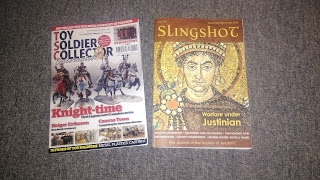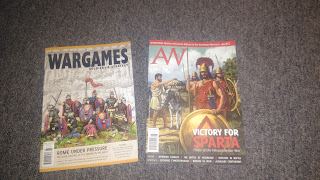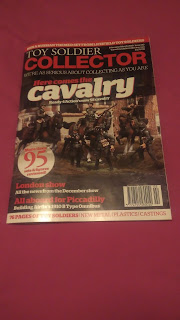INTRODUCTION
I HAVE decided this is a good time to publish the latest version of my rules, and some of my thinking behind the rules, ahead of our delayed 275th anniversary refight of the Battle of Dettingen.
The rules are, to a large extent, old school in their deliberate simplicity. I always want victory to go to the player with a better understanding of generalship, rather than a better understanding of the rules.
They are adapted, heavily at times, from Neil Thomas's inspiring books, specifically Wargaming: An Introduction and Napoleonic Wargaming.
To fully comprehend the thinking behind the rules, you will need to read his books; most of my explanations here will be about those instances where I have drastically changed his concepts.
 |
| Neil Thomas's books are old school, but slot into the more recent section of my chronologically arranged shelf of wargaming books |
Game Of Kings is designed to put you in the position of a mid-18th century European general.
He would not have known exactly how many men he had under his command. Instead, he would have known his army consisted of so many battalions of foot, squadrons of horse and guns of artillery.
European armies of this period tended to resemble each other in terms of arms, formations and tactics, eg battalions fought in lines rather than columns, and squadrons, including so-called dragoons, charged home rather than engaging in caracoling firefights.
Unit strengths varied between armies, but they varied much more within an army. Sickness, desertion and unreplaced casualties meant the fact that nation X's squadrons had a paper strength of 15 troopers more than nation Y's squadrons was of little relevance to what turned up on the battlefield.
That is why battalions, squadrons and guns in Games Of Kings are represented by the same number of figures in each army. However, that does not mean their fighting abilities will be the same.
One of the main features of Neil Thomas's rules is that his armies have a set number of units. I think this can work well with ancient armies, where the reported numbers for the contending sides are often pretty fanciful and hard to reconstruct accurately with any confidence.
This is much less so with the 18th century, especially when most battles have multiple contemporary accounts rather than a single author writing possibly centuries after the event.
So, in Game Of Kings, when refighting a historic battle, the number of units in each army will reflect the original strengths.
There will certainly not be a 1:1 ratio in terms of battalions, squadrons and guns, but there will typically be many more units than in Neil Thomas's armies.
This is turn required me to speed up combat mechanisms in order to prevent battles dragging on to the point where players might start looking at their watches.
Another difference between Game Of Kings and the books is that I have introduced simple command & control and morale rules.
Even so the rules, stripped of their explanations, comfortably fit on two sides of a sheet of A4 paper.
ORGANISATION
An army consists of a general on a base 20x20mm, and units of foot, horse and guns on bases 40x20mm.
A foot battalion has two bases in a line, each containing eight musketmen arranged in two ranks, and an 'officer' - it could be a drummer - to indicate the unit's state of effectiveness.
The officer is placed centrally behind the bases when the unit is at 100 percent effectiveness. After it suffers a "hit," which reduces the unit's effectiveness to 75 percent, the officer is moved to behind the righthand base.
After a further hit, reducing effectiveness to 50 percent, one of the bases is removed and the officer is placed centrally behind the remaining one. A third hit, reducing effectiveness to 25 percent, sees the officer removed, and a fourth hit means the remaining base is removed.
Note that this does not mean the unit has been wiped out, nor does losing 25 percent effectiveness mean the unit has suffered 25 percent casualties. Instead it represents a loss of effectiveness, which may be a combination of casualties, faltering spirit and disorganisation.
Light infantry is organised similarly, except that each base has three figures.
 |
| George II overlooks four battalions of British and Hanoverian infantry (left to right): Klinkowström at 100% effectiveness, Royal Foot at 75%, The Buffs at 50% and 5th Marines at 25% |
Cavalry can be heavy, medium or light, but each squadron consists of two bases, each with three troopers, and an 'officer'.
Heavy and medium horse can be distinguished by their equipment, eg a heavy cavalryman often wears a cuirass, while light horse should be placed on their base in ragged formation.
Cavalry bases are positioned one behind the other. Neil Thomas, who uses a similar system, explains this is to reflect the way cavalry kept a reserve when going into combat (and remember that a tabletop squadron represents several real-life ones). The exception is that light cavalry in a screening role may operate with bases in a line.
 |
| Prussian horse parade past an isolated farmhouse led by Brandenburg-Schwedt Cuirassiers at 100% effectiveness, followed by Posadowski Dragoons at 75%, Prinz von Preussen Cuirassiers at 50% and Bayreuth Dragoons at 25% |
A gun and four gunners are arranged lengthways on a single 40x20mm base. Loss of effectiveness can be shown with a marker, eg a miniature boulder.
 |
An Austrian 12pdr gun alongside Grenzer light infantry. There is no marker beside the gun, and the Grenzer officer is centrally placed, so both units are at 100 percent effectiveness
|








































